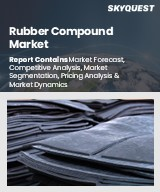
고무 컴파운드 세계 시장 규모는 2023년에 336억 달러, 2024년 356억 8,000만 달러에서 2032년에는 577억 4,000만 달러로 성장하고, 예측 기간(2025-2032년) CAGR은 6.2%를 보일 전망입니다.
세계 고무 컴파운드 시장은 타이어, 씰, 호스, 진동 감쇠 부품 등의 용도로 중요한 역할을 하는 자동차, 산업, 건설 등의 분야에서 수요가 증가하면서 큰 폭으로 성장하고 있습니다. 자동차 생산량 급증, 전기자동차 보급률 상승, 인프라 투자 지속 등으로 선진국과 신흥국 모두에서 소비를 촉진하고 있습니다. 주목할 만한 동향으로는 바이오 및 재활용 가능한 고무 컴파운드에 대한 선호도 증가, EPDM 및 SBR 블렌드 사용 확대, 고성능 요구사항에 대한 커스터마이징 증가 등을 들 수 있습니다. 그러나 원자재 가격 변동, 엄격한 환경 규제, 시장의 최종 사용자들의 역동적인 요구에 대응하기 위한 혁신적인 컴파운드 기술의 필요성 등의 과제도 남아있습니다.
Global Rubber Compound Market size was valued at USD 33.6 billion in 2023 and is poised to grow from USD 35.68 billion in 2024 to USD 57.74 billion by 2032, growing at a CAGR of 6.2% during the forecast period (2025-2032).
The global rubber compound market is experiencing significant growth, primarily propelled by heightened demand from sectors such as automotive, industrial, and construction, where these compounds play a crucial role in applications like tires, seals, hoses, and vibration dampening components. The surge in vehicle production, rising electric vehicle adoption, and ongoing infrastructure investments are driving consumption in both developed and emerging economies. Notable trends include a growing preference for bio-based and recyclable rubber compounds, increased utilization of EPDM and SBR blends, and heightened customization for high-performance needs. However, challenges persist, including fluctuations in raw material prices, stringent environmental regulations, and the need for innovative compounding technologies to address the dynamic requirements of end users in the market.
Top-down and bottom-up approaches were used to estimate and validate the size of the Global Rubber Compound market and to estimate the size of various other dependent submarkets. The research methodology used to estimate the market size includes the following details: The key players in the market were identified through secondary research, and their market shares in the respective regions were determined through primary and secondary research. This entire procedure includes the study of the annual and financial reports of the top market players and extensive interviews for key insights from industry leaders such as CEOs, VPs, directors, and marketing executives. All percentage shares split, and breakdowns were determined using secondary sources and verified through Primary sources. All possible parameters that affect the markets covered in this research study have been accounted for, viewed in extensive detail, verified through primary research, and analyzed to get the final quantitative and qualitative data.
Global Rubber Compound Market Segments Analysis
Global Rubber Compound Market is segmented by Product Type, Product Form, Rubber Type, Processing Method, End-User and region. Based on Product Type, the market is segmented into Synthetic Rubber and Natural Rubber. Based on Product Form, the market is segmented into Solid Rubber, Liquid Rubber and Powdered Rubber. Based on Rubber Type, the market is segmented into Silicone Rubber, Fluoro Rubber, Butyronitrile Rubber, EPDM Rubber and Chloroprene Rubber. Based on Processing Method, the market is segmented into Compression Molding, Injection Molding and Other Methods. Based on End-User, the market is segmented into Building & Construction, Automotive & Transportation, Industrial Machinery Equipment and Others. Based on region, the market is segmented into North America, Europe, Asia Pacific, Latin America and Middle East & Africa.
Driver of the Global Rubber Compound Market
The global rubber compound market is experiencing robust expansion, driven primarily by a surge in demand from the automotive industry, where rubber materials play a crucial role in the production of tires, seals, gaskets, hoses, and vibration dampers. The growing trend towards electric vehicles is contributing significantly to this demand, as lightweight, durable, and heat-resistant rubber compounds are essential for their components. Original Equipment Manufacturers are actively pursuing tailored solutions that improve performance in various applications, such as enhancing battery insulation, reducing noise, and providing effective weatherproofing. This shift signifies an evolving landscape in the rubber compound sector.
Restraints in the Global Rubber Compound Market
The Global Rubber Compound market faces significant constraints due to the intricate composition of rubber compounds, which include a diverse combination of natural and synthetic polymers, carbon black, plasticizers, and accelerators. Fluctuations in the prices of essential raw materials like natural rubber, butadiene, and EPDM, driven by geopolitical instability and logistical challenges, create difficulties for manufacturers in achieving consistent costs and ensuring reliable supply chains. These market dynamics make it increasingly challenging for producers to navigate their operations effectively, impacting overall productivity and profitability in the industry.
Market Trends of the Global Rubber Compound Market
The Global Rubber Compound market is witnessing a significant trend towards sustainability, marked by a growing investment in bio-based and recycled rubber compounds. By 2025, manufacturers are prioritizing innovative formulations that incorporate natural rubber, vegetable oils, and post-consumer rubber recyclates. This shift is largely driven by the imposition of stricter environmental regulations and the increasing sustainability aspirations of Original Equipment Manufacturers (OEMs). As a result, these eco-friendly alternatives are being widely embraced across various sectors, including automotive, construction, and consumer goods. The rising consumer demand for greener products is further propelling the growth of sustainable rubber compounds in the market.